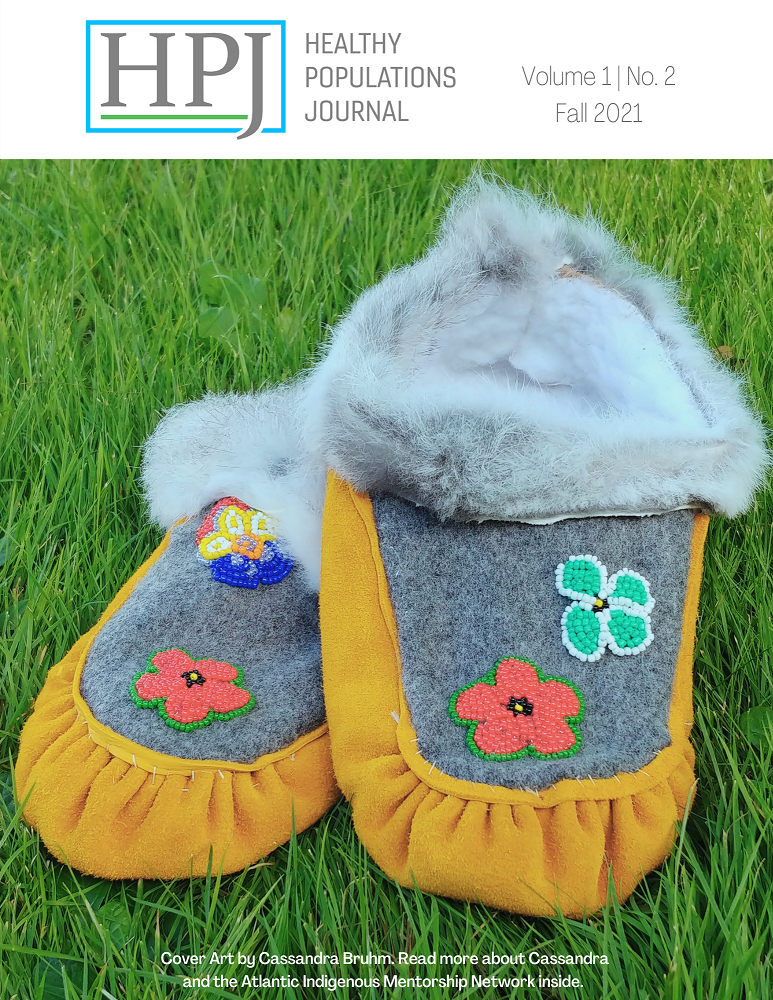Optional or Obligatory? Exploring Undergraduate University Students‘ Attitudes, Opinions, and Beliefs Around Verbal Sexual Consent
DOI:
https://doi.org/10.15273/hpj.v1i2.10658Abstract
Introduction: For the last 20 years, sexual assault on university campuses has occurred at epidemic levels. This may be caused by undergraduate students primarily using non-verbal cues to communicate sexual consent, despite high levels of miscommunication and misinterpretation. Explicit, verbalized consent is known to lead to fewer misinterpretations of consent; however, less is known about students‘ beliefs around verbal consent. Objectives: To explore Canadian undergraduate students‘ attitudes, opinions, and beliefs around verbal consent, and to investigate whether students believe verbal consent is always required during sexual encounters. Methods: This study used a qualitative description approach. Data was collected from 31 Canadian undergraduate students in a Human Sexuality course through an open-ended question embedded in an interactive course textbook. Students‘ responses were analyzed using thematic analysis. Results: Many complexities exist in undergraduate students‘ attitudes, opinions, and beliefs around verbal consent. Four major themes emerged from the data centring on familiarity, socio-cultural norms, reliance on non-verbal cues, and acknowledgement of the importance of verbal consent. Conclusion: The majority of participants believed that verbal consent was not required in all sexual encounters. Partner familiarity was a significant factor in using verbal consent. Social norms such as verbal consent being viewed as awkward or embarrassing were key barriers to students‘ use. Verbal consent was viewed as an ideal, while non-verbal consent was viewed as realistic.
References
Braun, V., & Clarke, V. (2006). Using thematic analysis in psychology. Qualitative Research in Psychology, 3(2), 77–101. https://doi.org/10.1191/1478088706qp063oa
Creswell, J. W., & Poth, C. N. (2018). Qualitative inquiry and research design: Choosing among five approaches (4th ed.). Sage Publications.
Criminal Code, RSC 1985, c. C-46, s. 271.1 (1).
Criminal Code, RSC 1985, c. C-46, s. 273.1 (1).
Curtis, J. N., & Burnett, S. (2017). Affirmative consent: What do college student leaders think about “yes means yes” as the standard for sexual behavior? American Journal of Sexuality Education, 12(3), 201–214. https://doi.org/10.1080/15546128.2017.1328322
Daigle, L. E., Johnston, T., Azimi, A., & Felix, S. N. (2019). Violent and sexual victimization among American and Canadian college students: Who is more at risk and are the risk factors invariant? Journal of School Violence, 18(2), 226–240. https://doi.org/10.1080/15388220.2018.1459631
Denzin, N. K., & Lincoln, Y. S. (Eds.). (2011). The Sage handbook of qualitative research (4th ed.). Sage.
Government of Canada (2019). JustFacts: Sexual assault. Department of Justice. https://www.justice.gc.ca/eng/rp-pr/jr/jf-pf/2019/apr01.html
Gray, J. M. (2015). What constitutes a “reasonable belief” in consent to sex? A thematic analysis. Journal of Sexual Aggression, 21(3), 337–353. https://doi.org/10.1080/13552600.2014.900122
Hermann, C., Liang, C. T. H., & DeSipio, B. E. (2018). Exploring sexual consent and hostile masculine norms using the theory of planned behavior. Psychology Of Men & Masculinity, 19(4), 491–499. https://psycnet.apa.org/doi/10.1037/men0000127
Jozkowski, K. N., Manning, J., & Hunt, M. (2018). Sexual consent in and out of the bedroom: Disjunctive views of heterosexual college students. Women‘s Studies in Communication, 41(2), 117–139. https://doi.org/10.1080/07491409.2018.1470121
Jozkowski, K. N., & Peterson, Z. D. (2013). College students and sexual consent: Unique insights. Journal of Sex Research, 50(6), 517–523. https://doi.org/10.1080/00224499.2012.700739
Jozkowski, K. N., Peterson, Z. D., Sanders, S. A., Dennis, B., & Reece, M. (2014). Gender differences in heterosexual college students‘ conceptualizations and indicators of sexual consent: Implications for contemporary sexual assault prevention education. The Journal of Sex Research, 51(8), 904–916. https://doi.org/10.1080/00224499.2013.792326
Marcantonio, T., Jozkowski, K. N., & Wiersma-Mosley, J. (2018). The influence of partner status and sexual behavior on college women‘s consent communication and feelings. Journal of Sex & Marital Therapy, 44(8), 776–786. https://doi.org/10.1080/0092623X.2018.1474410
Marcantonio, T. L., Jozkowski, K. N., & Lo, W.-J. (2018). Beyond “Just saying no”: A preliminary evaluation of strategies college students use to refuse sexual activity. Archives Of Sexual Behavior, 47(2), 341–351. https://doi.org/10.1007/s10508-017-1130-2
Miller, L., Brushett, S., Ayn, C., Furlotte, K., Jackson, L., MacQuarrie, M., Massie, A. S., Mathias, H., McKay, M., Meisner, B. A., Moritz, L., Stilwell, C., & Weeks, L. E. (2021). Developing a competency framework for population health graduate students through student and faculty collaboration. Pedagogy in Health Promotion, 7(3), 280–288. https://doi.org/10.1177%2F2373379919859607
Neergaard, M. A., Olesen, F., Andersen, R. S., & Sondergaard, J. (2009). Qualitative description – the poor cousin of health research? BMC Medical Research Methodology, 9, Article 52. https://doi.org/10.1186/1471-2288-9-52
Potter, S., Howard, R., Murphy, S., & Moynihan, M. M. (2018). Long-term impacts of college sexual assaults on women survivors‘ educational and career attainments. Journal of American College Health, 66(6), 496–507. https://doi.org/10.1080/07448481.2018.1440574
Pugh, B., & Becker, P. (2018). Exploring definitions and prevalence of verbal sexual coercion and its relationship to consent to unwanted sex: Implications for affirmative consent standards on college campuses. Behavioral Sciences, 8(8), Article 69. https://doi.org/10.3390/bs8080069
Quinlan, E., Clarke, A., & Miller, N. (2016). Enhancing care and advocacy for sexual assault survivors on Canadian campuses. Canadian Journal of Higher Education, 46(2), 40–54. https://doi.org/10.47678/cjhe.v46i2.185184
Sandelowski, M. (2000). Focus on research methods: Whatever happened to qualitative description? Research in Nursing & Health, 23(4), 334–340. https://doi.org/10.1002/1098-240X(200008)23:4%3C334::AID-NUR9%3E3.0.CO;2-G
Senn, C. Y., Eliasziw, M., Barata, P. C., Thurston, W. E., Newby-Clark, I. R., Radtke, H. L., Hobden, K. L., & SARE Study Team (2014). Sexual violence in the lives of first-year university women in Canada: No improvements in the 21st century. BMC Women‘s Health, 14, Article 135. https://doi.org/10.1186/s12905-014-0135-4
Top Hat (n.d.). Top Hat Classroom. https://tophat.com/classroom/
United Nations (n.d.). Goal 5: Achieve gender equality and empower all women and girls. https://www.un.org/sustainabledevelopment/gender-equality/
World Health Organization (2012). Understanding and addressing violence against women: Sexual Violence. https://apps.who.int/iris/bitstream/handle/10665/77434/WHO_RHR_12.37_eng.pdf;jsessionid=1B7DA2157511B30D07141C4561F4B03E?sequence=1


